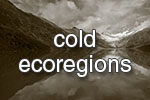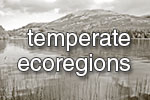Lakes in general - case studies
About case studies
Climate variables such as temperature or evapotranspiration are very strong predictors of aquatic and terrestrial diversity and set the outer limit to the ranges of many species. Accordingly, a shift in climatic variables can lead to shifts in the ranges of species across latitudes and altitudes (Burgmer et al, 2007).
By using meta-analysis techniques and with the help of species distribution models (SDM) predictions can be made of large distributional shifts in species and communities across large geographic scales.
A selection of case studies are presented for each ecosystems type (lakes, rivers and wetlands) demonstrating large-scale changes in the distribution of species and communities already occurring or that are predicted to take place in the future.
- Burgmer, T., Hillebrand, H., & Pfenninger, M. (2007). Effects of climate-driven temperature changes on the diversity of freshwater macroinvertebrates. Oecologia, 151(1), 93–103. doi:10.1007/s00442-006-0542-9
link to article - Logez, M., Bady, P., & Pont, D. (2012). Modelling the habitat requirement of riverine fish species at the European scale: sensitivity to temperature and precipitation and associated uncertainty. Ecology of Freshwater Fish, 21(2), 266–282. doi:10.1111/j.1600-0633.2011.00545.x
link to article
Selected case studies
Impacts of climate warming, waste water management and land use changes on the ecology in Lakes IJsselmeer and Markermeer (REFRESH outcome)

Cited work:
Los, FJ. 2009. Eco-hydrodynamic modelling of primary production in coastal waters and lakes using BLOOM. PhD Dissertation, Wageningen. ISBN 978-90-8585-329-9.
Ecosystem type:
Lakes
Variables being affected:
Physical (sediments, visibility, transparency), Chemical (nutrients), Biological (Fish, Mussels, Birds, Water vegetation)
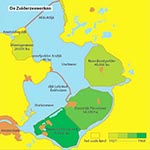 Click to enlarge
Click to enlarge
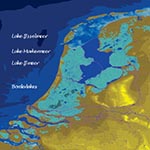 Click to enlarge
Click to enlarge
Key message:
When the Natura 2000 conservation objectives were set for Lakes IJsselmeer and Markermeer, they did not include restoration tasks despite the autonomous downward trend in bird numbers to such an extent that both the local and the national conservation status were unfavourable. This study will produce recommendations regarding the feasibility and viability of the Natura 2000 objectives and of a robust, future-proof ecological system. The possible causes for the downward trends in birds in Lake IJsselmeer and Markermeer can be divided into the following four categories:
- Long-term consequences from the closing-off and compartmentalising of the former South Sea (Zuiderzee), related particularly to accumulation and erosion/sediment processes;
- Reduction in the nutrients in the water (oligotrophication) after a period of eutrophication in the 1950s, 1960s and 1970s;
- Climate change resulting in warmer water in the summer and therefore lower oxygen values, and in a relatively big increase in temperature in the winter with a consequent reduction in ice cover and an earlier spring;
- Human use, such as fishing, recreation, sand extraction and windmills.
Background:
The former Southern Sea Estuary was transformed into freshwater Lake IJsselmeer in 1932 when an inlet from the Wadden Sea was closed by the Afsluitdijk. During the subsequent 35 years, land reclamation projects and further dam construction created Lake Markermeer, separated from IJsselmeer by the Houtribdijk, and a string of smaller border lakes. The lakes are classified as Heavily Modified Water Bodies under the European Water Framework Directive (Lammens et al. 2008).
 Click to enlarge
Click to enlarge
Lakes IJsselmeer and Markermeer, like other lakes in The Netherlands, are stressed by: unnatural morphology and water management regimes; anthropogenic nutrient inputs; inputs of silt; and other human and natural factors including climate change (Gulati and van Donk 2002). Because man-made Dutch lakes have steep shorelines, there is an abrupt transition from land to water and absence of substantive littoral marsh. High levels of nutrient input from agriculture have maintained the lakes in a turbid, phytoplankton dominated state, which may be stabilized by climate change (Jeppesen et al. 2003, Mooij et al. 2005, Moss et al. 2011). Lakes IJsselmeer and Markermeer currently have total phosphorus (TP) concentrations that average 100 and 60 µg/l, respectively, and chlorophyll a (CHLA) concentrations that average 40-60 and 30 µg/l. Turbidity is highest in Markermeer.
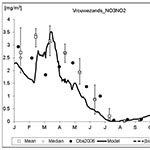 Click to enlarge
Click to enlarge
According to the Directorate-General for Public Works and Water Management (Rijkswaterstaat, RWS), Lakes IJsselmeer and Markermeer have experienced declines in certain species of waterfowl, including diving ducks (Greater Scaup, Common Goldeneye, Smew, Common Merganser and Tufted Duck) and fish-eating birds (Great Crested Grebe, Little Gull and Black Tern). A decline in food and nutrient resources is considered a possible cause of the waterfowl reductions, as there have been large declines of smelt in both lakes and a large decline of mussels in Markermeer. At the same time, climate change may be contributing to changes in the regional distribution of waterfowl, and as such, the driver for change in bird densities may be external to the lake ecosystems.
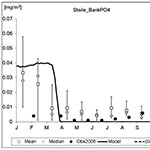 Click to enlarge
Click to enlarge
Climate change can have a number of effects on shallow eutrophic lakes – enhancing internal nutrient recycling and stabilizing turbid states, as noted above – and affecting use patterns of birds by changing water temperature. Climate change influences growth, mortality and respiration rates of algae. Higher temperature increases those rates and interferes with interspecies competition. Model simulations have been used to quantify changes in algae composition under various climate scenarios, such as G (+0.9°C) and Wp (+2.6°C). The model predicts higher cyanobacteria concentrations with increasing temperatures.
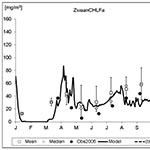 Click to enlarge
Click to enlarge
Lake IJsselmeer is facing decreasing nutrient concentrations, mainly due to effective waste water management in the upstream part of the Rhine river basin. The decrease in nitrogen and phosphorus loads has decreased nutrient concentrations, but has not yet resulted into lower chlorophyl-a concentrations.
Changes in water level height and dynamics due to water management has not changed the habitat suitability of key-species of the system. However, previous studies indicated that the seasonal timing of water level changes is crucial for ecology. An increase of water temperature will significantly affect the growth of macrophytes and mussels, and therefore the entire foodweb of Lakes IJsselmeer and Markermeer. The research programme basically addresses three main questions:
- What are the causal mechanisms of the downward trends in waterfowl?
- What are effective measures to counteract these trends, and what will they cost?
- What conservation goals are feasible?
The effect of climate change on the distribution of fish in Europe
Cited work:
Logez, C. M., Belliard, J., Melcher, A., Pletterbauer, F., Schmutz, S., & Gorges, G. (2012). Deliverable D5. 1-3: BQEs sensitivity to global / climate change in European rivers: implications for reference conditions and pressure-impact-recovery chains.
Ecosystem type:
Rivers, Lakes
Variable being affected:
Biological (Fish)
Background:
Temperature and hydrology are the main environmental drivers of fish species distribution along river networks. The observed and projected changes in climatic conditions imply modifications of the environmental conditions and thus of the habitat suitable for fish species. In response to these changes, shifts of fish species distributions are expected. From the scope of conservation, it is very important to anticipate the effect of global change on species occurrences so as to evaluate the loss and/or gain of habitat that would be observed depending on the gas emission scenarios. Logez and Pont have assessed the possible impacts of climate change on 23 widespread European fish species. Potential current and future distributions of species were predicted (for the years 2020–2030 and 2050–2060) using the 23 models, and the predicted probabilities of species presence for the 4543 sampling sites were computed.
Main results:
Generally, the scenario for the 2020–2030 period predicts that all fish species, except Atlantic salmon, are will experience distribution shifts, occur in new locations and disappear from sites where they were present. Specifically, bleak, eel, barbel, nase, gudgeon, chub, dace, perch, ninespine stickleback, bitterling, roach and soufie are expected to experience an expansion of their distribution areas (more new occurrences than new absences). Stone loach, bullhead, northern pike, threespine stickleback, lamprey, burbot, minnow, Atlantic salmon, brown trout and grayling are expected to have a contraction of their distribution areas.
Conclusions:
The projections highlight that climate-change pose a major threat for species preferring cold- to cool-water temperatures, even for relatively eurythermal such as brown trout. On the other hand, species preferring warmer temperatures and with large thermal ranges will be less affected by climate change and may even be favoured by it. Climate change will also hasten the species turnover and modify the composition of the species assemblage. Indeed the stream sections with suitable environmental conditions will be greatly reduced for species such as Atlantic salmon and grayling, whereas bitterling and bleak will occur in many more reaches. For species with intermediate thermal preferences, the response patterns are more contrasted, with environmental conditions becoming either suitable or unsuitable. For these species, a shift in their distribution is expected, both at the watershed scale and over their distribution area.
Impacts of climate warming on the long-term dynamics of key fish species in 24 European lakes.
Cited work:
Jeppesen, E., Mehner, T., Winfield, I. J., Kangur, K., Sarvala, J., Gerdeaux, D., Rask, M., et al. (2012). Impacts of climate warming on the long-term dynamics of key fish species in 24 European lakes. Hydrobiologia, 694(1), 1–39. doi:10.1007/s10750-012-1182-1
Ecosystem type:
Lakes
Variable being affected:
Biological (Fish)
Background:
Fish play a key role in the trophic dynamics of lakes. With climate warming, complex changes in fish assemblage structure may be expected owing to direct effects of temperature and indirect effects operating through eutrophication, water level changes, stratification and salinisation. The authors reviewed published and new long-term (10–100 years) fish data series from 24 European lakes (area: 0.04–5,648 km2; mean depth: 1–177 m; a north–south gradient from Sweden to Spain).
Main results:
Along with an annual temperature increase of about 0.15–0.3°C per decade profound changes have occurred in either fish assemblage composition, body size and/or age structure during recent decades and a shift towards higher dominance of eurythermal species. These shifts have occurred despite a reduction in nutrient loading in many of the lakes that should have benefited the larger-sized individuals and the fish species typically inhabiting cold-water, low-nutrient lakes. The cold-stenothermic Arctic char has been particularly affected and its abundance has decreased in the majority of the lakes where its presence was recorded. The harvest of cool-stenothermal brown trout has decreased substantially in two southern lakes. Vendace, whitefish and smelt show a different response depending on lake depth and latitude. Perch has apparently been stimulated in the north, with stronger year classes in warm years, but its abundance has declined in the southern Lake Maggiore, Italy. Where introduced, roach seems to take advantage of the higher temperature after years of low population densities. Eurythermal species such as common bream, pike–perch and/or shad are apparently on the increase in several of the lakes.
Conclusions:
The response of fish to the warming has been surprisingly strong and fast in recent decades, making them ideal sentinels for detecting and documenting climate-induced modifications of freshwater ecosystems.
Climate change and the future distributions of aquatic macrophytes across boreal catchments
Cited work:
Alahuhta, J., Heino, J., & Luoto, M. (2011). Climate change and the future distributions of aquatic macrophytes across boreal catchments. Journal of Biogeography, 38(2), 383–393. doi:10.1111/j.1365-2699.2010.02412.x
Ecosystem type:
General
Variable being affected:
Biological (primary producers)
Background:
Aquatic–terrestrial ecotones are vulnerable to climate change, and degradation of the emergent aquatic macrophyte zone would have severe ecological consequences for freshwater, wetland and terrestrial ecosystems. The aim of this study was to uncover future changes in boreal emergent aquatic macrophyte zones by modelling the occurrence and percentage cover of emergent aquatic vegetation under different climate scenarios in Finland by the 2050s. Data derived from different GIS sources were used to estimate future emergent aquatic macrophyte distributions in all catchments in Finland (848 in total). Generalized additive models (GAM) were used to explore the main environmental determinates (climate and geomorphology) of emergent aquatic macrophyte distributions, which were derived from the national subclass of CORINE land- cover classification. The accuracy of the distribution models (GAMs) was cross- validated, using percentage of explained deviance and the area under the curve derived from the receiver-operating characteristic plots.
Main results:
The results indicated that emergent aquatic macrophytes will expand their distributions northwards from the current catchments and percentage cover will increase in all of the catchments in all climate scenarios. Growing degree-days was the primary determinant affecting distributions of emergent aquatic macrophytes. Inclusion of geomorphological variables clearly improved model performance in both model exercises compared with pure climate variables.
Main conclusions:
Emergent aquatic macrophyte distributions will expand due to climate change. Many emergent aquatic plant species have already expanded their distributions during the past decades, and this process will continue in the years 2051–80. Emergent aquatic macrophytes pose an increasing overgrowth risk for sensitive macrophyte species in boreal freshwater ecosystems, which should be acknowledged in management and conservation actions. We conclude that predictions based on GIS data can provide useful ‘first-filter’ estimates of changes in aquatic–terrestrial ecotones.
Effect of climate change on the presence of blue-green algae
Cited work:
Paerl, H. W., & Paul, V. J. (2012). Climate change: links to global expansion of harmful cyanobacteria. Water research, 46(5), 1349–63. doi:10.1016/j.watres.2011.08.002
O’Neil, J. M., Davis, T. W., Burford, M. a., & Gobler, C. J. (2012). The rise of harmful cyanobacteria blooms: The potential roles of eutrophication and climate change. Harmful Algae, 14, 313–334. doi:10.1016/j.hal.2011.10.027
Ecosystem type:
Lakes
Variable being affected:
Biological (primary producers)
Background:
Cyanobacteria (blue-green algae) are the Earth’s oldest known oxygen-producing organisms; they have a broad geographic distribution, ranging from polar to tropical regions in northern and southern hemispheres, where they are capable of dominating planktonic and benthic primary production in diverse habitats. Recent research suggests that eutrophication and climate change are two processes that may promote the proliferation and expansion of cyanobacterial harmful algal blooms. The aim of this study, was to describe the relationships between eutrophication, climate change and representative cyanobacterial genera from freshwater (Microcystis, Anabaena, Cylindrospermopsis), estuarine (Nodularia, Aphanizomenon), and marine ecosystems (Lyngbya, Synechococcus, Trichodesmium).
Main results:
Commonalities among cyanobacterial genera include being highly competitive for low concentrations of inorganic P (DIP) and the ability to acquire organic P compounds. Both diazotrophic (= nitrogen (N2) fixers) and non-diazotrophic cyanobacteria display great flexibility in the N sources they exploit to form blooms. Hence, while some cyanobacterial blooms are associated with eutrophication, several form blooms when concentrations of inorganic N and P are low. Cyanobacteria dominate phytoplankton assemblages under higher temperatures due to both physiological (e.g. more rapid growth) and physical factors (e.g. enhanced stratification), with individual species showing different temperature optima. Significantly less is known regarding how increasing carbon dioxide (CO2) concentrations will affect cyanobacteria, although some evidence suggests several genera of cyanobacteria are well-suited to bloom under low concentrations of CO2.
Main conclusions:
While the interactive effects of future eutrophication and climate change on harmful cyanobacterial blooms are complex, much of the current knowledge suggests these processes are likely to enhance the magnitude and frequency of these events. Evidence from geographically-diverse aquatic ecosystems varying in size, morphology, salinity and hydrologic conditions, indicates that climatic change can act synergistically with anthropogenic nutrient enrichment to promote global expansion of bloom-forming cyanobacteria.
Lakes as sentinels of climate change
Cited work:
Adrian, R., O’Reilly, C. M., Zagarese, H., Baines, S. B., Hessen, D. O., Keller, W., Livingstone, D. M., et al. (2009). Lakes as sentinels of climate change. Limnology and oceanography, 54(6), 2283–2297.
Ecosystem type:
Lakes
Variable being affected:
Lakes
Background:
Lake Ecosystems may be regarded as sentinels because they provide indicators of climate change either directly or indirectly through the influence of climate on the catchment. The indicators are measurable response variables, such as water temperature, dissolved organic carbon (DOC), or plankton composition. Specifically, lakes are likely to serve as good sentinels for current climate change because (1) lake ecosystems are well defined and are studied in a sustained fashion; (2) lakes respond directly to climate change and also incorporate the effects of climate-driven changes occurring within the catchment; (3) lakes integrate responses over time, which can filter out random noise; and (4) lakes are distributed worldwide and, as such, can act as sentinels in many different geographic locations and climatic regions, capturing different aspects of climate change (e.g., rising temperature, glacier retreats, permafrost melting).
Main results:
There is diverse set of variables responsive to climate that span a range of physical, chemical and biological properties in lakes. These variables reflect either a direct influence of climate on the lake or an indirect change via the effect of climate on the catchment:
- Water temperature: can be highly correlated with regional-scale air temperatures.
- Water level: reflects the dynamic balance between water input (precipitation, runoff) and water loss (evaporation), and the timing of the ice-free season.
- Ice phenology: the timing of ice-off makes a better direct indicator of climate change than the timing of ice-on.
- Chemical variables: Nutrient concentrations and ratios in lakes are likely to be altered as a consequence of changes in terrestrial export related to climatic influences and to internal processes related to changes in thermal structure and/or primary productivity.
- Dissolved organic carbon (DOC): integrates multiple responses within the lake, such as water transparency, heat absorption, and lake metabolism, as well as changes in the catchment and increased CO2 concentrations.
- Oxygen concentrations: can indicate climate shifts because oxygen levels are strongly influenced by temperature and thermal structure.
- Biota: changes are expected in growth rates, abundance, and species composition, including invasion by alien species.
Main conclusions:
Lakes have a strong potential as sentinels of current climate change and, as such, can contribute to our understanding of global climate effects. As sentinels, lakes provide a way to detect and monitor the effects of climate change at the ecosystem scale in locations that are under-represented in climate studies or are influenced by other environmental changes.






